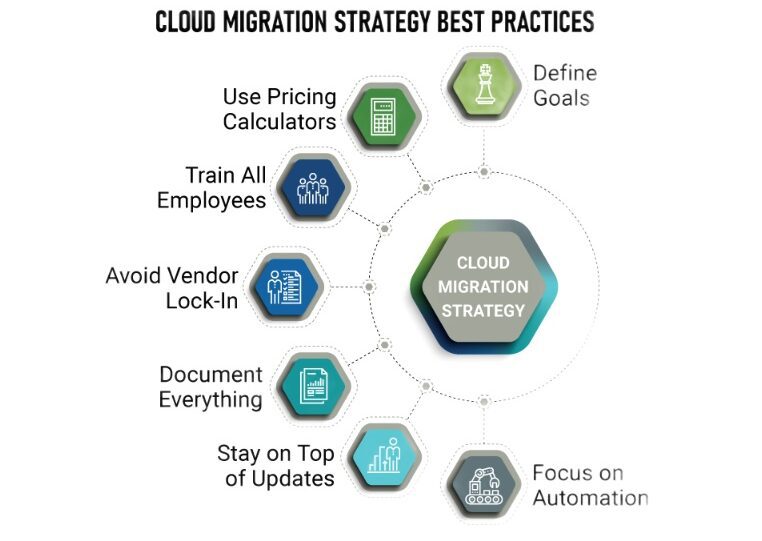Cloud migration is inevitable for companies that want to remain relevant in the digital-first economy. With companies fast realizing this, cloud adoption is at its peak. According to a Google report, 41.4% of the companies are planning to increase their investment in cloud products and services, while 33.4% of others are keen on moving their legacy software to a cloud environment. Cloud migration is seeing rapid adoption due to the several benefits that it has to offer:
- Enhanced customer experience
- Better business agility
- Efficient workflows
Cloud migration helps companies prepare for the uncertain future. Although organizations are looking forward to being future-ready, most of them lack knowledge on how to approach it.
In this blog, we give you a detailed outline of how to plan and implement your cloud migration strategy.
Preparing your cloud migration strategy

For a successful cloud migration, there are multiple strategies and frameworks that you can follow. It essentially involves the key steps as explained below.
1. Identifying suitable workload for migration
Cloud migration usually takes place in phases. This is especially true for businesses that cannot afford complete disruption of services. Therefore, all the concerned stakeholders must first identify the workloads that they can afford to move. Most organizations move non-critical business processes that have no or minimal dependencies to the cloud and then take up migration of business-critical workloads.
2. Aligning your cloud strategy with business needs
Once you prioritize the migration, it is time to determine your cloud strategy. There are multiple ways you can adopt cloud computing – public, private, multi-cloud, and hybrid. Deciding the type of cloud approach is entirely dependent on your asset management, application maintenance, and cost optimization strategies.
3. Meeting security and compliance needs
When moving to the cloud, there is a chance of introducing new security risks and compliance challenges. You need to ensure that the cloud provider meets your security and compliance requirements, such as data protection, encryption, and access control. Organizations should also implement security best practices in their cloud migration process, such as assessing API vulnerabilities, using tools like firewalls, antivirus, and encryption.
4. Optimizing cloud cost management
Cloud migration offers cost saving benefits in terms of reduced hardware costs and faster deployments. It also provides greater scalability, improved security, and access to the latest features. However, cloud migration can also incur hidden costs, such as data transfer fees, licensing fees, etc. It is important for organizations to estimate and monitor the costs associated with cloud migration.
Choosing the right data migration method
Organizations need to plan and execute data migration carefully while considering data loss prevention, compatibility, data validation, etc. Organizations also need to choose the right data migration method, such as lift-and-shift, refactor, rearchitect, or rebuild.
5. Conducting validation post-migration of apps
Once you migrate your assets and workloads, they must work efficiently in the new environment. You assess that by comparing the ‘before and after’ performance of your software in a test environment for both technical and business terms.
Now that you understand the core steps of cloud migration, let’s dive into Gartner’s 5 Rs of cloud migration strategies.
6. Gartner’s Cloud Migration Strategies
Back in 2011, Gartner defined five fundamental cloud migration strategies. These strategies are:
- Rehost
- Refactor
- Revise
- Rebuild
- Replace
7. Rehost
In this strategy, you pick a chunk of your workload and transfer an exact copy onto the cloud platform. Rehosting, as the name suggests, involves hosting the entire thing from on-premises to the cloud without any modifications or alterations. This works best for companies that require quick ROI and have a conservative approach to business.
8. Refactor
Refactoring is when you can rebuild your entire software onto the cloud platform. This strategy, also known as rearchitecting allows organizations to modernize their offerings adding new cloud-based capabilities. Here migration is achieved rather easily with cloud providers facilitating infrastructure for building the application. One of the most expensive cloud migration methods, refactoring builds future-compatible applications.
9. Revise
When you want to modernize your applications by extending your existing codebase, you can take up a Revise cloud migration strategy. It falls somewhere between Rehost and Refactor. You attempt to update your existing legacy applications using the infrastructure and resources provided by cloud platforms.
10. Rebuild
Like the name implies, Rebuilding involves you building your enterprise applications from scratch. You will have to train your team on new cloud-based technologies so that they can implement a cloud-centric application development strategy. While it may sound like a hassle and time-consuming process, Rebuilding is the most cost-effective cloud migration strategy.
11. Replace
The final strategy in Gartner’s framework is Replace. It means organizations can replace their legacy enterprise application with a commercial SaaS-based product. That means you chuck your software in favor of a third-party, cloud-native solution. Replace migration strategy may seem like a stress-free approach, but it could lead to vendor lock-in and dependability on third-party providers for data access.
Cloud migration demands detailed planning
As much as it is important, cloud migration is complicated. It requires meticulous planning, execution, and testing, which requires extensive resources in terms of budget, workforce, and time. If you intend to attempt cloud migration on your own, you can start by putting together a team that you manage every step of the process. Otherwise, you can onboard a cloud migration service provider like Prismberry to streamline your cloud migration process. Prismberry helps you move to the cloud with minimal disruption to your business operations. We provide a comprehensive suite of services, from deployment to ongoing maintenance, to ensure a successful cloud migration.


